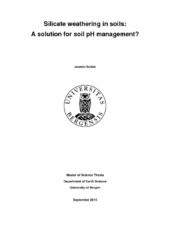| dc.description.abstract | N2O released form agricultural soils is mainly a product of denitrification; a key microbial process in the N cycle. The relative rate of N2O released from this process depends of the soil pH, where the relative amount of N2O to denitrified N (N2O/N2+N2O) increase in more acidic soils. pH management in soils is mainly based on carbonate based liming, which will release CO2 to the atmosphere during dissolution or at later acidification. Use of non-carbonate rock powders for pH management in agriculture can thus significantly decrease greenhouse gas emissions if they increase soil pH sufficiently. Mafic minerals have basic reactions and dissolve slower than dolomite and calcite. This thesis presents laboratory dissolution experiments examining the dissolution mechanisms in soils and compare dissolution rates and pH increase capacity of a set of rock samples, including the effect of mineral and organic acids. The work was divided in two parts. Part one was examination of olivine and anorthosite dissolution in soils using a scanning electron microscope after 1.5 years of soil incubation. The purpose of the examination was to identify and quantify visible dissolution structures, and examine if the observed dissolution features were most likely to increase or inhibit further dissolution. The purpose of the experiments in part two was to measure and compare the pH increase, dissolution rates and heavy metal leaching of olivine, anorthosite, dolomite, nepheline syenite, larvikite, eclogite and norite under acidic conditions. The acids used were HNO3, HCl, oxalic acid, acetic acid (+ HCl) and a combination of peat soil and HCl. The experiments were conducted in stirred, open batch reactors at room temperature with initial pHs from 1 to 3, where pH was allowed to increase freely upon reaction with minerals. Fractures, etch-pits and silica-layers were present on both olivine and anorthosite grains after 1.5 y in peat soil. In addition some olivine grains display serpentinization features and Al oxide-layers. The olivine grains were generally far more weathered than the anorthosite grains, and they also increased the soil pH more (pH 4.4 vs 4.0) respectively. The formation of silicate layers can probably inhibit dissolution, however it seems as the silicate layers break up and flake off over time, and they are typically not found on the same surfaces as acid pitting was found. Fractures and etch-pits will increase the grain surface area, however it is uncertain if the formation of etch-pits increase the reactive surface area, particularly in anorthosite. Olivine, nepheline syenite and norite gave the highest pH increase of the silicates (but lower than dolomite). Dissolution rates were decreasing with increasing pH. Organic acids or peat soil slurry had a significant effect compared to HCl, however the effect of chelating agents was different between the rock types, and the relative order of dissolution rates between rocks were not altered by adding acids with chelating effects. Oxalic acid and peat soil seem to increase the dissolution and solubility of heavy metals as Ni more than major elements as Mg or Ca. High concentrations of Ni in norite and olivine and leachates might lead to restrictions in use for agricultural purposes. | en_US |
